Large-fruited tomatoes are the best varieties for growing
Everyone who is fond of gardening, horticulture or maintains greenhouses wants to show off to their relatives or friends the beautiful, juicy and tasty fruits of their labor. Therefore, to grow large-fruited a tomato - not an easy task, but worth it. After all, such a vegetable is much sweeter and tastier than small or medium-sized tomatoes.
Content:
- Benefits of large-fruited tomatoes
- Planting and care technology
- Types of early maturing varieties
- Mid-season varieties
- Late-ripening varieties
- The most productive and new varieties
Benefits of large-fruited tomatoes
When it's time to plant tomato, often every gardener or greenhouse asks the question: which variety of tomatoes is best to grow so that it is tasty fresh in food, retains its shape and density when preserved, despite the heat treatment with boiling water.
The best solution is to choose large-fruited varieties of tomatoes - they are eaten fresh and quickly and allow you to prepare a lot of pickles, juices for the winter, and you can even get a good profit from it.
After all, huge fruits have a light and at the same time tough skin, which allows them to be stored for a long time and not to deteriorate.
In general, large-fruited tomatoes are valued for their qualities such as:
- Taste. They are ideal both for fresh salads and for self-consumption.
- Juiciness. Large tomatoes are very juicy, so you can make tomato juice, sauces, ketchup and fillings from them (they have a thin skin that is very easy to separate from the pulp). Opening such a delicacy in winter you will plunge into the warm atmosphere of that time.
- Tall and yield... These qualities will allow you to use the land area as efficiently as possible.
Thus, growing such a vegetable in your garden or in a greenhouse, you can not only pamper your relatives and friends with fresh and canned delicacies, but also get a good profit from selling it.
Planting and care technology
The peculiarity of large-fruited tomatoes is that they can grow strongly up and around. In order to get ripe large tomatoes, you must adhere to the following instructions:
- Late-ripening varieties should be planted first somewhere in late winter - early March. Then the mid-ripening and early-ripening ones. Having landed the seeds in February, remember that they should be supplemented with special lamps. This procedure must be done so that the plant grows faster, many buds form and the ovary of the first brush does not fall off.
- When seedlings for about 50 days - it can be safely planted in a greenhouse following a planting scheme of 40 x 60 cm.
- After the tomatoes are planted in the greenhouse, it is necessary to pinch them, leaving only one or two stalks. This is a simple process - it is enough to remove the lateral shoots and their growths so that the main stem is strong and grows faster. The stepson should not break out completely, leave a small process in its place of 2 cm so that it does not grow again.
- After 4 days after planting, the plant must be tied up.
- Each stem should have no more than 5 flower clusters.
- When the tomato has reached its maximum height or when the last flower cysts have already formed, the tops of the tomato must be pinched, leaving 3 leaves above the brush itself. Thanks to this, the plant will not grow so intensively and will project all its strength for ripening. tomato... Also, the leaves stimulate the processes of photosynthesis.
- Monitor the humidity and temperature in the greenhouse. It should not exceed 30 ° C.
- Tie bushes to supports. This will prevent them from falling to the ground and the tomato bushes will not break from the weight of the fruit. The best option is vertical trellises with a stretched wire over them. Cords or ropes are lowered down from it, around which the stem is twisted as it grows. The brushes are tied separately.
- Remember about feeding... In order to know when to feed the plant, just follow it. If you notice that the leaves are beginning to turn yellow, feed the tomatoes with sodium sulfate.
- Do not allow the soil under the plant to dry out, otherwise it will shed its flowers and stop growing. Tomatoes especially need moisture during fruit setting.
By adhering to these simple recommendations, you will get huge fruits of tomatoes on your site.
Types of early maturing varieties
Experienced vegetable growers distinguish the following among early-ripening varieties:
- Scorpio is large-fruited. Its peculiarity is that the scorpion is grown only indoors. He gives very early harvest... Depending on the light, the color of the fruit can vary from bright pink to deep crimson. Also, the fruits can reach after they have been plucked from the stem. The weight of one fruit is 800 (g).
- Raspberry giant. The fruit is ribbed, flat-round. Has a raspberry pink color. It tastes very sweet and does not crack. Suitable for canning. Weight - from 200 (g).
- Ural. The fruits are smooth and round. This is a salad variety tomato... The plant needs to be tied up and pinned. Weight - 400 (g).
- Handbag. Suitable for growing only in greenhouses, as it gives an early harvest. It has sugary fruits, very sweet in taste. Used for fresh consumption. Weight - from 200 (g).
- Cavalcade. An unpretentious variety of large-fruited tomatoes. The fruits are very large and tasty. It is sufficiently resistant to pests.
- Gilgal. It belongs to the earliest tomato varieties. Tomatoes are stored for a very long time and do not spoil. They taste good. Weight - up to 350 (g).
Do not forget that almost all early maturing varieties should grow in greenhouses.
Mid-season variety
Among mid-ripening varieties of large-fruited tomatoes, the following are distinguished:
- Cardinal. This variety should be grown in greenhouses with a height of about 2 meters. Tomatoes are very fleshy and sweet. They are crimson in color and heart-shaped. Suitable for both salads and seaming. Weight - 800 (g).
- Bear Paw. Fleshy and sugar fruits. They have a flat-round shape. The plant needs regular pinching and their planting should be no more than three stems per 1 m2. Weight - up to 800 (g).
- Kirzhach. Gives an excellent harvest even under unfavorable conditions. The fruits are bright red and have a glossy skin. Very juicy. Weight - 300 (g).
- Rosamarin. The plant is small in height. Fruit color is bright pink. The tomato is even, rounded, smooth. Weight - 400 (g).
- Volgograd... This variety is best grown in a greenhouse. The fruits are large enough and taste good. They can be stored for up to a month and a half and do not choke during transportation. Weight - 350 (g).
Late-ripening varieties
- Spartacus. The plant has a high yield. A tomato itself is fleshy and sweet. Weight - 220 (g).
- Funtik. The fruits are delicious, ribbed and soft. Weight - up to 220 (g).
- Krasnobai. It has even, rounded fruits. Drain strong aroma. They have tender flesh. Suitable for canning. Weight - up to 500 (g).
- Russian size. The fruit from this variety of tomatoes is smooth, juicy and fragrant. Weight - 500 (g)
- Siberian. A very aromatic variety of large-fruited tomatoes. The maximum weight of which is up to 500 (g).
- Khrustyk. Suitable for growing in greenhouses.It has yellow, rounded fruits. It tolerates transportation well. The pulp is firm. It has a long shelf life and an unusual taste. Weight - 210 (g).
Late-ripening varieties of large-fruited tomatoes will delight you in late autumn with their aroma, freshness and taste.
The most productive and new varieties
Large-fruited varieties tomato often also called beef. Gardeners and breeders have developed new varieties of tomatoes that differ in their tastes, sizes and yields.
The most popular varieties are:
- Grandma's secret. It belongs to the category of super large-fruited varieties. The fruit is very fleshy and has few seeds. Weight - from 1 kg.
- Goose egg. New variety. The fruits are bright red in color and medium in size. Ripen quickly after being removed from the bush. Weight - 300 (g).
- De Barao is a giant. A very popular variety. Tomatoes have a cuboid shape, excellent taste. Very juicy. Suitable for fresh consumption and for seaming. Weight - 300 (g).
- Alsou. A novelty from Siberian breeders. Provide high yield - 9 kg per 1 m2. Tomatoes are kidney-shaped and rich in bright color. Weight - up to 800 (g).
- Siberian trump card. Suitable for cultivation outdoors. It is considered the sweetest and most fruitful variety of large-fruited tomatoes. Tomatoes are fleshy and juicy. The yield is 5 kg per bush. The weight of one tomato is up to 700 (g).
- Siberian troika. Suitable for outdoor cultivation. Does not need pinning. The fruits are fleshy, tasty and aromatic. Weight - up to 350 (g).
Large-fruited varieties of tomatoes are the best choice for gardeners.
They not only provide high yields, but they themselves tomato very tasty. In addition, they are easily transported, stored for a long time and are suitable for fresh consumption and when rolled, they turn out to be very tasty and fragrant. Early ripening, mid-ripening and late varieties of such tomatoes will allow you to enjoy them until the very cold.
More information can be found in the video.





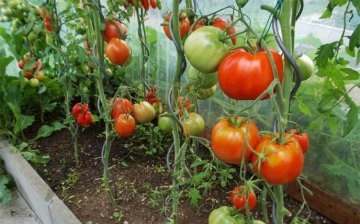

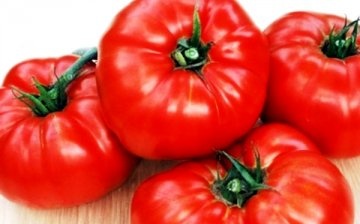
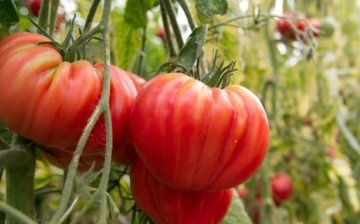
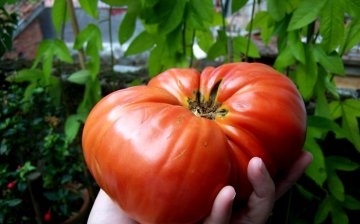








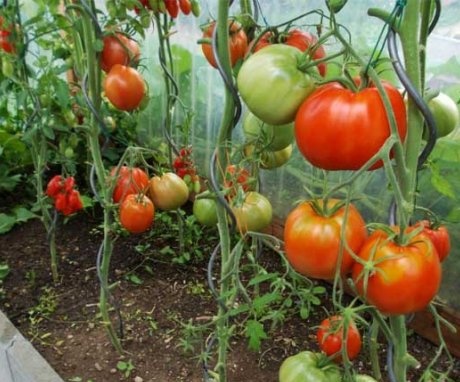

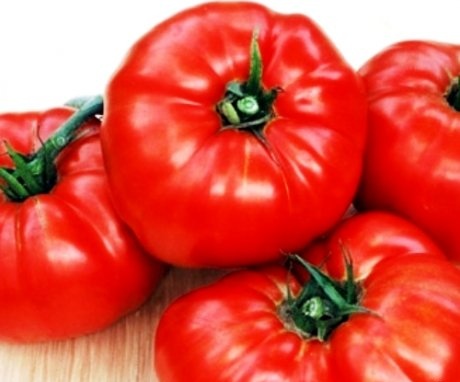
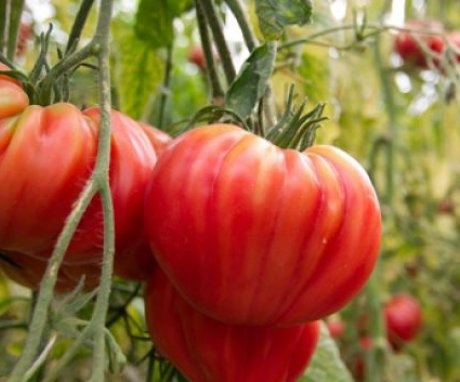
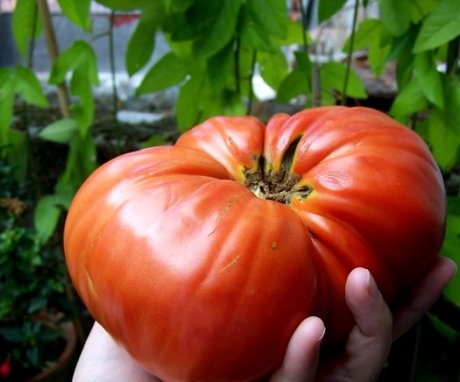
Large-fruited tomatoes are favorites in my garden. Such a question: when is it better to pinch the crown of indeterminate varieties so that the fruits have time to ripen in the greenhouse before the onset of cold weather?
I always, only my stepson tomatoes, and I have never pinched the top. We plant large tomatoes not according to varieties, but according to seedlings purchased on the market. We always ask you to sell large tomato seedlings. Sometimes they grow to a normal size, and sometimes they don't.